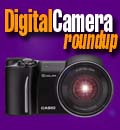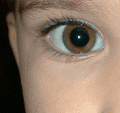|
Long Zoom Digital Cameras
We tested eight mid-priced models with 5x and greater zoom range.
By Conrad H. Blickenstorfer
8 state-of-the-art big zoom digital cameras. All have 5X
optical zoom or better. Some up to 12X. Some are large, some are
small. All are quite affordable. We tell you which is best overall,
best for big zoom work, and best to just take along with you.
One
of the great things about digital photography is that even inexpensive
digicams come with optical zooms. That's because of their humble
origins as sub-megapixel cameras less than ten years ago. In those
days of 640 x 480, 800 x 600 or perhaps 1024 x 768 resolutions,
you simply needed an optical zoom to get close enough to a subject
without having to crop the picture until so few pixels were left
that the image looked like something from an Atari 2600 video game.
That started the tradition of equipping even budget digicams with
good optical zooms, mostly of the 3X variety. 3X isn't much, but
it is is perfectly workable. It gets you in a bit closer, and in
this day and age of multi-megapixel cameras you have so much resolution
available that cropping a megapixel or three hardly makes a difference.
However,
there are those instances where you want a big zoom so that you
can get really close. That comes in handy when you want to get close-ups
of people in crowds, at sports events, when bird watching, attending
a baseball game or a car race, or numerous other situations when
you just can't get close enough or when it isn't practical. In those
instances, the bigger the optical zoom, the better. "But why not
digital zoom?" you may ask? "My camera has a 4X digital zoom, so
when I multiply that with my 3X optical zoom I get 12X total magnification."
Not true. Most digital zooms simply look at part of the picture
the optical zoom provides and then fill in extra pixels. This means
you don't get more resolution at all. You just get a fairly poor
quality image with lots of pixels. Some camera companies have ,smart 0/00
digital zooms that can result in improved picture qualities. They
either do this with special software manipulation or by limiting
the smart zoom to the lower resolution modes so that the digital
zoom can ,borrow 0/00 unused imager pixels to improve the picture. Any
which way you look at it, optical zoom is the only "real" zoom.
So
what do you need to look out for when you realize that you want,
or need, a big optical zoom? You can, of course, get a digital SLR
and then simply buy whatever lens you want. But for the purpose
of this review, we will limit ourselves to less expensive point&shoot,
consumer and prosumer cameras where cost is an issue. A bigger optical
zoom generally means higher cost. So you need to decide what's good
enough for your needs. You may be happy with a slightly higher magnification,
like 4X or 5X. That can make just enough of a difference to get
you the pictures you need. However, it won't be enough if you want
to get really close. For that you,ll want the biggest zoom you can
get, and those are in the 8X to 12X range.
Big
optical zooms are terrific, but they also have drawbacks. In general,
the bigger the zoom, the larger the lens and the more it'll stick
out, making the camera bulky. And the bigger the optical zoom, the
more important it becomes to shoot with a steady hand. Some cameras
have anti-shake technologies that work remarkably well. However,
it almost always pays to invest in a tripod (or even a monopod).
Further, a big optical zoom also requires a good LCD or viewfinder,
or else you can't really see what you're talking a picture of. Some
of the big zoom digicams have electronic instead of optical viewfinders,
just like older video cameras. The problem there is that electronic
viewfinders often have a "grainy" picture even if they have relatively
high resolutions.
It's
in the nature of comparison tests that they include different kinds
of cameras designed for different users and applications. Therefore,
we rate cameras not on just one scale, but tell you how suitable
they are for different users, and which ones rate highest for a
given purpose.
With
this lineup of big zoom cameras, we decided it would be best to
rate them on three different scales. First, how well they work overall.
Here we look at the big picture. Second, how well they work as big
zoom camera. Here's how well suited the camera is when used almost
exclusively in big zoom mode. And third, for those instances where
you need a big zoom but don't have room for one, how small and handy
the camera is. You decide which rating is most important to you.
As
far as pricing goes, posting list prices is almost useless as cameras
are always heavily discounted, and getting more so as they reach
end-of-life. So for this review we used the average price listed
for each camera on www.pricescan.com at the time we conducted the
lab tests, which was early September.
For
image quality tests, all cameras were loaded with fully-charged batteries,
reset to their factory settings, digital zoom was disabled if necessary,
and auto-flash was enabled/popped up if necessary. All shots were
taken on a tripod and triggered by a ten-second shutter release
delay to eliminate any movement from touching the shutter release.
For the macro tests, all cameras were set to macro mode, zoomed
back to maximum wide angle position, centered on the subject, and
triggered by the ten-second delay timer. Please note that this test
only shows how the camera performs with its defaults. A skilled
photographer may be able to do significantly better.
We
hope this roundup of Big Zoom cameras will give you a better idea
of what,s out there, what you can do with each camera, and which
one will fit your requirements, lifestyle, and budget best.
Canon
Powershot S2IS
 The
Powershot S2IS is digital camera powerhouse Canon,s newest entry
into the big zoom market. It replaces the older Powershot S1IS,
which it surpasses in every respect: bigger zoom, more megapixel,
better electronics, larger LCD display, more powerful flash, and
so on. But how does the Canon fare against the competition? Is it
a good choice for someone who wants a big zoom? The
Powershot S2IS is digital camera powerhouse Canon,s newest entry
into the big zoom market. It replaces the older Powershot S1IS,
which it surpasses in every respect: bigger zoom, more megapixel,
better electronics, larger LCD display, more powerful flash, and
so on. But how does the Canon fare against the competition? Is it
a good choice for someone who wants a big zoom?
That
depends. If you're looking for something to stow away in an attache
case or a purse (let alone a shirt pocket), forget it. The S2IS
is a big, heavy camera. The kind that immediately marks you as a
serious photographer. You can't hide this Canon. You can't use it
to quickly take some sneak shots without everyone noticing the big
matte silver plastic body. And if you're caught up in the megapixel
race you,ll be disappointed with the camera's "mere" 5mp.
If,
however, you want a true big zoom camera with lots of power and
plenty of features, the S2IS will definitely make your short list.
It has a massive 12X optical zoom~the digital equivalent of a 36
to 432mm 36mm lens. When you want to get that close, you need image
stabilization, which Canon supplies, or better yet a tripod (jeers
for the plastic thread). If 12X is still not enough, multiply that
with a passable 4X digital zoom for a total of 48X. That almost
gets you into the next county.
Adding
to the camera's flexibility is a twist (180 degrees) and rotate
(270 degrees) LCD. It allows you to take pictures overhead or shoot
from the hip. The flipside of the flexible display solution is that
the LCD itself is fairly small--just 1.8 inches. It is viewable outdoors,
but just barely. The camera doesn't have an optical viewfinder,
but uses the LCD. You can toggle between LCD display or LCD viewfinder
(which has a diopter adjustment).
Ergonomics
are quite good. The big body fits nicely into your right hand. The
big ,power bulge 0/00 that holds the camera's four AA batteries helps.
Most controls are where you expect them, but the implementation
isn't perfect as the body is cluttered with far too many hard-to-decipher
icons icons and markings of various colors. In sharp contrast, the
on-screen menus are clear and logical. Virtually all choices are
in text, and since you can view the LCD through the viewfinder,
you can see the menus outdoors as well.
I've
never liked the shutter to sit inside the zoom ring and I've never
liked overly cluttered mode dials. The S2IS has both. It also has
a large button with a red dot on it just where your thumb rests.
Push it and the camera starts recording movies. Not a good solution.
I can see the button getting activated inadvertently and the camera
filling the card with movies. One the other hand, you can take movies
in full zoom. Combine that with full 640 x 480 res at 30 frames
per second, image stabilization, and stereo sound recording! Even
more amazingly, you can take full res pictures DURING movie recording.
Perhaps Canon put that big button there on purpose. The S2IS is
almost like having a video camera.
This
being a Canon, expect all the usual superb electronics, making the
camera quicker and smarter than most. The S2IS will also appeal
to serious photographers with its full manual modes, its numerous
features, and enough tricks to keep you entertained for weeks or
months. Be prepared to spend a bit of time figuring it all out as
the learning curve~if you want to get the most out of this camera~is
somewhat steep.
The
big Canon disappointed in the macro test. Its autofocus never managed
to latch on the right spot and the result was an unsatisfying image.
In full zoom mode, the Canon managed excellent exposure, decent
focus, but far too much purple fringing. In the 1X test shot, the
Canon took a decent shot with excellent exposure and focus in the
distance.
Cool:
* Superb 12X zoom lens with anti-shake
* Terrific movie mode with zoom and stereo
* Extensive manual control, tons of features
Not
so cool:
* Big and bulky plastic body
* Too many incomprehensible icons
* Camera this good should have RAW support
Rating
for:
overall-10.0
big zoom use-9.6
take-along-9.2
Casio
Exilim EX-P505
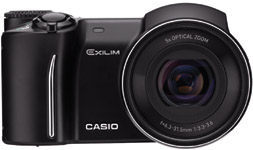 Casio
has perhaps been one of the biggest surprises of the digital camera
era, establishing itself as a premier maker of elegant, innovative,
high quality products that always seem to be a step ahead of everyone
else. it's all too easy to fall in love with one of Casio,s ultra-slender
little wonders, and then it's terrific to find that with the Casios,
beauty is far more than just skin-deep. Does the same apply to the
EX-P505 which in many ways represents a departure from Casio,s proven
recipes? Casio
has perhaps been one of the biggest surprises of the digital camera
era, establishing itself as a premier maker of elegant, innovative,
high quality products that always seem to be a step ahead of everyone
else. it's all too easy to fall in love with one of Casio,s ultra-slender
little wonders, and then it's terrific to find that with the Casios,
beauty is far more than just skin-deep. Does the same apply to the
EX-P505 which in many ways represents a departure from Casio,s proven
recipes?
For
starters, this camera is actually a lot smaller than it looks in
the pictures above. In some ways. Its 3.5 x 2 inch footprint would
appear small enough to make the EX-P505 pocketable. It would be
if it weren,t for the big 5X optical zoom (38-190 mm equivalent).
The lens barrel makes the Casio almost three inches deep, so forget
about sticking it into a pocket. This camera is totally defined
by its big lens and you can,t help but wonder why, as Pentax and
HP, for example, managed to totally retract their 5X lenses inside
bodies just one inch thick. Did Casio want to make a fashion statement
here, or did they struggle with unfamiliar design issues?
All
that said, the camera is actually quite elegant. The semi-gloss
black body is cleanly and beautifully designed. Every line and curve
is both beautiful and functional. All controls are in the right
place and clearly marked. There is no clutter, no wasted space,
no confusion. The P505 is elegant and purposeful where most other
Casios go for the ultra-high-tech look.
Other
things are different as well: there is no optical viewfinder. Instead,
Casio sprang for a LCD panel that is both large (2.0 inches diagonal)
and flexible. You can flip it out and rotate it, allowing for shots
that you just can,t take with a fixed display. Unfortunately, the
display isn't very high res with just 85k pixel (354x240).
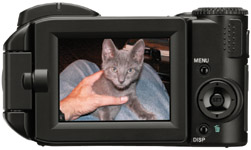 Casio's
motto is ,expect the unexpected, 0/00 and that certainly holds true
for the EX-P505,s many clever features. The pop-up flash actually
pops up automatically instead of stupidly waiting for the operator
to open it. In manual mode, the camera zooms in to 2X so it's easier
to focus. Even in a camera this small, Casio included two microphones
so you can record in stereo. The Li-Ion battery has a retainer clip
so it doesn't fall out when you open the door to insert or remove
a SD Card. there's 7.5MB of internal memory so you're not entirely
out of luck if the storage card is full or you forgot to put one
in (it can happen). And who,d want to miss Casio,s ,U-Boot 0/00 display
mode or the terrific live histograms?
Casio's
motto is ,expect the unexpected, 0/00 and that certainly holds true
for the EX-P505,s many clever features. The pop-up flash actually
pops up automatically instead of stupidly waiting for the operator
to open it. In manual mode, the camera zooms in to 2X so it's easier
to focus. Even in a camera this small, Casio included two microphones
so you can record in stereo. The Li-Ion battery has a retainer clip
so it doesn't fall out when you open the door to insert or remove
a SD Card. there's 7.5MB of internal memory so you're not entirely
out of luck if the storage card is full or you forgot to put one
in (it can happen). And who,d want to miss Casio,s ,U-Boot 0/00 display
mode or the terrific live histograms?
While
many small cameras limit themselves to being fully automatic point
& shooters, the EX-P505 offers much more flexibility. It can be
used as a simple snapshot camera, but it also has a full complement
of semi-manual and manual modes. And also no less than four movie
modes, plus you can zoom in up to 4X while watching movies. And
use the optical zoom while you take movies.
In
the speediness department, the Casio is a mixed bag. It starts up
quickly, the auto-focus is fast enough, but cycle time between pictures
is a bit slow.
The
Casio performed well in the macro test. It wasn't the sharpest,
but found a good balance in focus and exposure. The full 5X zoom
test shot was perfectly exposed but not as well focused as others.
There was also excessive purple fringing and over-sharpening. The
1X test shot looked good because the Casio fired its flash, but
it also managed to present a well-balanced, sharp image.
Looking
at the overall test scores the P505 managed against this strong
competition, I am surprised that it didn,t do better. At the very
least I would have expected it to win the ,take along 0/00 category,
but that lens needlessly massive barrel is just too big.
Cool:
* Very clean and functional design
* Powerful features, plenty of cool stuff
* Strong battery, excellent macro
* Several movie modes, stereo sound
Not
so cool:
* Small size negated by large lens barrel
* Relatively slow cycle time
Rating
for:
overall-8.8
big zoom use-7.3
take-along-9.0
Fujifilm
FinePix S9000
 Almost
every comparison test has its 800-pound gorilla, and the Fujifilm
FinePix S9000 fills that roll in our lineup of big zoom digicams.
Place it next to our three 12X zoom cameras~the Canon S2IS, the
Konica Minolta Z5, and the Sony DSC-H1~and they look like 3/4-scale
models next to the big Fuji. To give you an idea of the price you
pay when you go for this formidable piece of equipment: It weighs
nearly twice as much as the also rather hefty Canon. With its 10.7X
optical lens (28-300mm equivalent) in resting position it is 5.5
inches deep. With the lens fully extended almost seven inches. Almost
every comparison test has its 800-pound gorilla, and the Fujifilm
FinePix S9000 fills that roll in our lineup of big zoom digicams.
Place it next to our three 12X zoom cameras~the Canon S2IS, the
Konica Minolta Z5, and the Sony DSC-H1~and they look like 3/4-scale
models next to the big Fuji. To give you an idea of the price you
pay when you go for this formidable piece of equipment: It weighs
nearly twice as much as the also rather hefty Canon. With its 10.7X
optical lens (28-300mm equivalent) in resting position it is 5.5
inches deep. With the lens fully extended almost seven inches.
At
first sight you,d swear this was a SLR. The size, the design, the
weight. The huge 1/1.6-inch Super CCD HR imager with its 9 megapixel
resolution~nearly twice that of all other ,big zoom 0/00 cameras in
this lineup. An ISO range from 80 all the way to 1600. And the big
lens that you adjust manually with your hand. With this camera Fuji
truly blurs the line between digital SLRs and standard digicams.
And speaking of blur, right on the big mode deal is an ,anti-blur 0/00
mode that any S9000 owner will almost immediately come to love.
Yet,
this is no SLR, and that means you get some of the goodies DSLR
users can only dream of. Like a superb 640 x 480 movie mode with
sound and full zoom, and even the ability to record at 60 frames
per second in VGA resolution. 30 second voice memos. A terrific
lens without the fear of getting the optics all dusty. A special
,Focus check 0/00 enlargement mode where part of the LCD or electronic
viewfinder zooms in so you can make sure your subject is in complete
focus.
Like
every other major digicam manufacturer, Fuji has its proprietary
electronic special sauce~in this case the 5th generation Super CCD
HR sensor and Real Photo Technology. Super CCD HR arranges pixels
in a special way to increase dynamic range with different size pixels.
Real Photo reduces graininess and noise. Judging by the excellent
pictures the camera produced, it works.
 In
everyday use, the big Fuji is a handful, just like any SLR would
be. You quickly come to appreciate the manually operated zoom lens,
the four AA batteries that can quickly be replaced, and the fact
that the camera has both an xD-Picture and a much more common CF
Card slot. Switching between the two is via menu. If only one card
is inserted, the S9000 knows which to use. The 1.8-inch LCD is a
bit small, but that goes for most LCDs that can be flipped or rotated.
The S9000,s does not rotate, but works well for overhead and from-the-hip
shooting. The electronic viewfinder is large and fairly clear. Physical
buttons and controls are generally large and clearly marked. There
is a bit of a learning curve. As mentioned, the anti-shake feature
works well, but you still might want to use a tripod. The Fuji has
a metal threaded mount for that. And while the pop-up flash is powerful,
there is also a standard shoe. In
everyday use, the big Fuji is a handful, just like any SLR would
be. You quickly come to appreciate the manually operated zoom lens,
the four AA batteries that can quickly be replaced, and the fact
that the camera has both an xD-Picture and a much more common CF
Card slot. Switching between the two is via menu. If only one card
is inserted, the S9000 knows which to use. The 1.8-inch LCD is a
bit small, but that goes for most LCDs that can be flipped or rotated.
The S9000,s does not rotate, but works well for overhead and from-the-hip
shooting. The electronic viewfinder is large and fairly clear. Physical
buttons and controls are generally large and clearly marked. There
is a bit of a learning curve. As mentioned, the anti-shake feature
works well, but you still might want to use a tripod. The Fuji has
a metal threaded mount for that. And while the pop-up flash is powerful,
there is also a standard shoe.
The
Fuji didn,t do as well as expected in the macro test. The image
was reasonably sharp, but unevenly exposed and too dark and contrasty.
The full-zoom test shot was excellent with perfect exposure and
focus, almost zero purple fringing. The only criticism would be
a bit of softness here and there. The 1X test shot was as expected~excellent.
What
it all amounts to is that the Fuji S9000 is not only the 800-pound
gorilla of this bunch, but also a very different camera in general.
It offers superb resolution and quality, most of the consumer features
expected from a non-SLR, but it all comes in such a large package
that many may simply spend the extra money for a true digital SLR.
Cool:
* High quality images and 9 megapixel
* Extensive manual controls
* Excellent movie mode
* Combines SLR and consumer features
Not
so cool:
* Very big and heavy
* Small LCD
Rating
for:
overall-9.9
big zoom use-10.0
take-along-8.3
HP
PhotoSmart R817
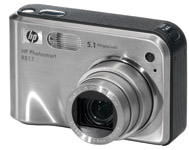 Though
Hewlett Packard has been selling digital cameras for a long time,
somehow we never had high expectations for any HP camera. While
no one would ever question HP,s technological competence, for some
reason the computing behemoth generally seems content to issue ho-hum
digicams that are dumbed down to an extent that makes them nearly
unusable for any serious photographer. I made the mistake once to
buy an entry level digicam for my young son. In that case ,entry
level 0/00 meant just plain bad. HP seemed more interested in selling
complete ,systems 0/00 that would lock in consumers via gigabytes of
shovelware and strong recommendations to use other HP peripherals
and consumables. There are some indications that HP is seeing the
error in its ways. As of this writing, HP no longer sells any digicam
under 4 megapixel. And there is now a good variety of pretty interesting
cameras. Though
Hewlett Packard has been selling digital cameras for a long time,
somehow we never had high expectations for any HP camera. While
no one would ever question HP,s technological competence, for some
reason the computing behemoth generally seems content to issue ho-hum
digicams that are dumbed down to an extent that makes them nearly
unusable for any serious photographer. I made the mistake once to
buy an entry level digicam for my young son. In that case ,entry
level 0/00 meant just plain bad. HP seemed more interested in selling
complete ,systems 0/00 that would lock in consumers via gigabytes of
shovelware and strong recommendations to use other HP peripherals
and consumables. There are some indications that HP is seeing the
error in its ways. As of this writing, HP no longer sells any digicam
under 4 megapixel. And there is now a good variety of pretty interesting
cameras.
Truth
be told, you wouldn,t expect a new beginning just from the looks
of the PhotoSmart R817. Its oddly designed brushed metal body with
a cheap-looking faux carbon fiber insert doesn't look like much.
Ergonomic indents in the metal look more like the camera has been
banged up (though they fit your fingers nicely). Else, there really
isn't much to say about the design.
Amazingly,
once you get over preconceived notions and the ho-hum first impression,
the R817 is actually a pretty nice camera. For starters, it is very
small and compact for a 5 megapixel, 5X optical zoom camera. At
3.6 x 2.25 x 1.2 inches and weighing under 6 ounces, the HP is one
of only two truly pocketable cameras in this lineup (the other is
the Pentax Optio SV---hmmm, the HP is using a Pentax lens). That
alone will net HP a bunch of sales. The picture above shows the
camera's 5X zoom fully extended. When the R817 is turned off, the
lens completely retracts into the camera body, making the HP far
handier than, for example, the Casio with its huge lens barrel.
Move
on to the LCD and there is another nice surprise. Not only is the
display large enough (2.0 inches), but it also offers the highest
resolution of any LCD in this lineup, by a lot. We,re talking 153k
pixels and 640x240 resolution while the others generally languish
in the 115k range. Sure, without a optical viewfinder the HP needs
a good LCD, but it's still a plus.
Controls
are neat and clean and kept to a bare minimum. there's an on-off
switch, four buttons (flash, focus, mode, timer) that bring up on-screen
menus, a dedicated movie button next to the shutter, and a novel
third-of-a-circle zoom segment that you operate by rolling your
thumb left and right. It works, but takes some getting used to.
Moving
on to features, the HP can hold its own. This is not just a point
& shooter; HP equipped the R817 with aperture and shutter priority
modes as well as a program and a manual mode. Exposure compensation
operates by a full six EV points (all others do just four), and
the 5X optical zoom can be digitally multiplied to a full 40X (not
recommended). It also has a cool panorama stitch mode that glues
the pictures together right in the camera. And there's even speed.
The camera starts up quickly, focuses quickly, and cycles quickly.
Nice. The menus are a pleasure as well. Everything is clear and
logical. there's even an on-screen Help mode that provides guidance
on how to use features.
There
are some not-so-clever features. For example, to charge the battery
or connect to a computer you need to use the included dock. And
you either love or hate the many hundreds of megabyte worth of software
HP plows onto your hard drive.
The
HP,s macro performance was difficult to judge because the camera
grossly overexposed the test shot. The picture was sharp enough,
but would have to be corrected in software. The 5X zoom test shot
looked very pleasant if a bit too contrasty, with perfect focus,
good exposure and virtually no purple fringing. The no-zoom test
shot benefited from the camera flashing, but focus in the center
was marginal. Overall a much better performer than we expected.
And the perfect zoom camera to take along.
Cool:
* Small, handy, truly pocketable
* Very easy to use, very clear menus
* Speedy, nice features, even manual modes
* Large, high-res LCD
Not
so cool:
* Looks cheap
* Nice software, but way too much of it
Rating
for:
overall-9.2
big zoom use-7.1
take-along-10.0
Konica
Minolta DiMAGE Z5
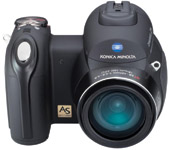 I
am probably biased when it comes to the Di-MAGE Z5. When it first
arrived at our office, I immediately fell in love with it and chose
it as my new daily driver, the camera I use for almost everything.
Cameras with massive zooms are usually massive in size as well,
but that doesn't apply to the Z5. True, the big lens assembly dominates
the camera, with the ,power bulge 0/00 seemingly attached to its side
as an afterthought, but the Z5 is neither unwieldy nor very heavy.
You certainly can,t stick it in your pocket, any of them, but it
also doesn't require special gear to carry it along. it's both simple
and extremely versatile. You can use it to take great closeup shots,
but the first time you take it to a ball game or any other place
where you need to get real close to the action, that,s when you
truly get hooked. In this day and age, 5 megapixel is the bare minimum
if you use a camera almost all day long, but then again, that,s
what all but one of the contenders in this lineup have. And with
a big zoom you don't have to crop nearly as much, so your megapixels
go a long way. I
am probably biased when it comes to the Di-MAGE Z5. When it first
arrived at our office, I immediately fell in love with it and chose
it as my new daily driver, the camera I use for almost everything.
Cameras with massive zooms are usually massive in size as well,
but that doesn't apply to the Z5. True, the big lens assembly dominates
the camera, with the ,power bulge 0/00 seemingly attached to its side
as an afterthought, but the Z5 is neither unwieldy nor very heavy.
You certainly can,t stick it in your pocket, any of them, but it
also doesn't require special gear to carry it along. it's both simple
and extremely versatile. You can use it to take great closeup shots,
but the first time you take it to a ball game or any other place
where you need to get real close to the action, that,s when you
truly get hooked. In this day and age, 5 megapixel is the bare minimum
if you use a camera almost all day long, but then again, that,s
what all but one of the contenders in this lineup have. And with
a big zoom you don't have to crop nearly as much, so your megapixels
go a long way.
What
it all means is that if you're interested in a somewhat different
camera with a tremendous optical zoom and lots of good, common-sense
features, and can live with the relatively bulky body a big optical
zoom lens necessitates, Konica Minolta,s DiMAGE Z series will almost
certainly be of interest to you. The DiMAGE Z5 has a uniquely styled
body that looks like a SLR but isn't; a relatively cumbersome overall
shape due to the big lens; a ,switchfinder 0/00 that uses one and the
same LCD for external viewing and as the basis for an electronic
viewfinder; excellent ergonomics; an amazing range that covers extreme
close-ups all the way to a massive 12X optical zoom; and a terrific
anti-shake feature that makes the 12X optical zoom far more useful
that it has any right to be. In the Z5, Konica Minolta also replaced
the dinky little 1.5-inch LCD of the Z5,s predecessor models with
a higher resolution 2.0-inch display. The new and larger LCD makes
a huge difference. You no longer have to squint to see what,s on
the screen. I'd like more than the rather stingy 115k pixel resolution,
but in this class almost everyone else is playing Scrooge as well.
The Z5 is very fast. I never have to wait, and that is important
to me. Add to that a separate compartment for the SD Card slot and
the four standard AA batteries, very cleanly and clearly marked
controls, and a simplicity of operation rarely found these days
in ever more complex digital cameras, and you have a winner. While
the DiMAGE Z5 didn,t actually win any of the three categories, it
is one of only three models to score in the 9s in every category~talk
about well balanced.
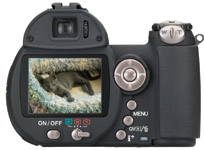 Unfortunately,
a few shortcomings carried over from earlier models and they may
have cost the DiMAGE an outright win: the flash still doesn't pop
up automatically, but most serious users will likely use an external
flashlight anyway. And the diopter adjustment is still right next
to the eye-piece where it's almost impossible to adjust. And, shamefully,
the DiMAGE Z5 is the only camera in this entire lineup to have no
audio annotation or voice memo feature at all. You get sound with
the very nice 640 x 480 movie mode, and that,s it. Unfortunately,
a few shortcomings carried over from earlier models and they may
have cost the DiMAGE an outright win: the flash still doesn't pop
up automatically, but most serious users will likely use an external
flashlight anyway. And the diopter adjustment is still right next
to the eye-piece where it's almost impossible to adjust. And, shamefully,
the DiMAGE Z5 is the only camera in this entire lineup to have no
audio annotation or voice memo feature at all. You get sound with
the very nice 640 x 480 movie mode, and that,s it.
In
our image quality testing, the multi-talented DiMAGE Z5 struggled
with our macro test shot. It hunted for good focus and exposure
but delivered neither (unlike in my own daily work with it). The
12X zoom shot was beautifully exposed and in near-perfect focus,
but suffered from unacceptable purple fringing in high contrast
areas. However, it pretty much aced the short zoom test where it
offered the overall best balance between perfect exposure and proper
focus.
Cool:
* Small and handy for a 12X zoom camera
* Overall excellent picture quality
* Clean, clear design and menus
* Powerful features, yet simple operation
Not
so cool:
* Flash doesn't pop up automatically
* No audio annotations or voice memos!
Rating
for:
overall-9.6
big zoom use-9.1
take-along-9.0
Olympus
C-5500 Zoom
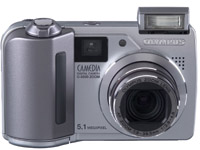 According
to IDC, a Massachusetts research firm, Olympus is having a tough
time in the US market. In the second quarter of 2005, Olympus, marketshare
dropped from 10.9% to 6.4%, a distant fourth, just barely ahead
of HP, Fuji and Nikon, and way behind Kodak, Canon and Sony. This
is weird because not only is Olympus a pioneer in the digital camera
market, but they also have a strong and ever-improving lineup of
state-of-the-art cameras. So barring any potential behind-the-scene
issues, if I had to come up with an explanation for this drop, I'd
have to say that a) Olympus cameras usually look workmanlike rather
than exciting and thus are not likely to stand out on a crowded
shelf, and b) Olympus cameras often suffer from a rather convoluted
menu system that may cause potential buyers to put the camera back
on the shelf in frustration. I may be wrong. According
to IDC, a Massachusetts research firm, Olympus is having a tough
time in the US market. In the second quarter of 2005, Olympus, marketshare
dropped from 10.9% to 6.4%, a distant fourth, just barely ahead
of HP, Fuji and Nikon, and way behind Kodak, Canon and Sony. This
is weird because not only is Olympus a pioneer in the digital camera
market, but they also have a strong and ever-improving lineup of
state-of-the-art cameras. So barring any potential behind-the-scene
issues, if I had to come up with an explanation for this drop, I'd
have to say that a) Olympus cameras usually look workmanlike rather
than exciting and thus are not likely to stand out on a crowded
shelf, and b) Olympus cameras often suffer from a rather convoluted
menu system that may cause potential buyers to put the camera back
on the shelf in frustration. I may be wrong.
I do
feel quite confident, however, in saying that anyone who passes
on the C-5500 Zoom is missing out on a very good camera at a great
price. According to pricescan.com, at the time we finished this
roundup in September 2005, the C-5500 was available for an average
price of just US$235, by far the least expensive of this group.
For that you get an attractively styled and very well made camera
with a 5.1 megapixel imager, a very good 5X zoom lens that covers
the 36-180mm equivalent, both automatic and manual modes, excellent
ergonomics, a large 2-inch LCD and enough features to keep most
photographers entertained and happy. there's even an anti-shake
feature to stabilize things when you use the big zoom. So while
the camera has been around for quite some time (in digital camera
terms, anyway), the C-5500 represents a great balance of price,
features, and performance. it's simple enough for beginners and
powerful enough for serious photographers. it's large enough to
accommodate four AA batteries (a solution we still like very much
because you can get them anywhere) and a 5X zoom lens that fully
retracts inside the housing, yet it isn't bulky or unwieldy (unless
you compare it to the diminutive HP or Pentax).
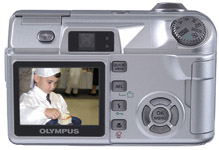 However,
before you sprint to the local discount store to bag a C-5500 or
order one online, consider some of the not-so-great aspects of this
camera. However,
before you sprint to the local discount store to bag a C-5500 or
order one online, consider some of the not-so-great aspects of this
camera.
If
you're into movies, the C-5500 is among the weakest in this lineup.
At this point, a maximum movie size of 320 x 240 pixels is no longer
acceptable, not when others do it at 640 x 480 or better, with stereo
sound, dedicated movie buttons and more. Sure, this is no vidcam,
but people do like movie clips. And the C-5500 also can,t zoom while
you're shooting clips.
Audio
mode is equally weak. Four second audio clips per picture isn't
much compared to the competition, some of which are veritable dictaphones.
Then
there are little things that, somehow, you expect from a camera
that looks as serious as this one: A diopter adjustment for the
viewfinder, for example, a pop-up flash that actually pops up automatically
when needed, or a decent printed English manual rather than a few
pages of basic instructions in a multi-language booklet, with the
rest on CD. Then there are the xD-Picture cards, a fine format,
but a less common one. That works for me as long as the camera has
dual slots, but if you go xD-Picture only, chances are you need
to buy all new cards and card readers. Finally, there's the Olympus
user interface that you either love or hate. I find it needlessly
confusing with its multiple levels of inconsistent menus and icons.
This is really too bad as the overall ergonomics of the camera are
very good. Everything is clear and in the right spot.
The
inexpensive Oly surprised us with the best macro performance of
all cameras. The test picture was sharp and properly exposed. The
5X zoom test shot was also excellent, with perfect focus, no purple
fringing, and excellent exposure. The C-5500 did average with the
no-zoom test shot, providing only average exposure and sharpness.
Cool:
* Great looks and design quality feel
* Excellent 5X optical zoom
* Superb ergonomics
Not
so cool:
* Confusing menus and controls
* Only 20-second movie clips
* Marginal software and manuals
Rating
for:
overall-8.2
big zoom use-7.8
take-along-8.2
Pentax
Optio SV
 In
the second half of 2005, the 5-megapixel subcompact appears to have
become the definitive all-purpose, take-everywhere digicam for virtually
everyone. The price/performance/size equation all work well. In
the second half of 2005, the 5-megapixel subcompact appears to have
become the definitive all-purpose, take-everywhere digicam for virtually
everyone. The price/performance/size equation all work well.
Canon
pioneered the boxy little metal-bodied design with their PowerShot
S-series/Digital ELPH models. They,re still here and doing quite
well but other makes have caught up to Canon,s pioneering efforts.
Pentax brings a few neat tricks to this party with their popular
Optio S line, the latest of which is the lovely and talented Option
SV. Built in the mold of the 5MP, 3X-zoom Optio S5i, the SV offers
a much larger 5X zoom to the feature mix using Pentax,s unique ,folding 0/00
lens design. You get a slightly fatter lens that zooms to 185mm
equivalent telephoto that magically extends no more than your typical
3X zoom optic does. Unlike Minolta,s original ,flat 0/00 zoom technology
for subcompacts, the Pentax design does not compromise image quality
perceptibly. In fact, this camera exhibits a welcome lack of pincushion
and barrel distortion at the zoom extremes.
I,ll
admit to not really warming up to the original Optio models; they
seemed derivative, overpriced, and somewhat slow compared to the
cameras of the day. These were the kind of cameras you,d like if
you were given one as a present but not if you,d paid for one yourself.
Obviously, Pentax figured out how to hit the ELPHin sweet spot,
as the latest Optios are fine cameras that can even please grumpy,
nitpicking photo editors like us.
Except
for one little thing: speed. The Optio SV, as nice as it is in most
respects, is still comparatively pokey in the shutter lag department.
If you routinely take pictures of things that move quickly, you
may not be totally happy with the SV.
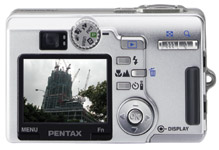 If
you can get past the speed issue, you have much in the Optio SV
that will make you happy. It has that long 5X zoom, the aforementioned
superb optical performance, a super-macro mode that get you in insanely
close (just over an inch), an auto-throttling flash for close-ups,
auto-bracketing, 320 x 240 @ 30fps movies limited only be SD card
size, USB2, AV-out port to connect to your TV, and a very sharp,
115,000-pixel LCD you can see outdoors. You also get a trick docking
station that can charge an optional spare battery pack. Speaking
on the dock, it does not let you face the back of your camera outwards,
as the excellent Casio Exilim docks do, meaning you can,t use them
as mini-digital picture frames. If
you can get past the speed issue, you have much in the Optio SV
that will make you happy. It has that long 5X zoom, the aforementioned
superb optical performance, a super-macro mode that get you in insanely
close (just over an inch), an auto-throttling flash for close-ups,
auto-bracketing, 320 x 240 @ 30fps movies limited only be SD card
size, USB2, AV-out port to connect to your TV, and a very sharp,
115,000-pixel LCD you can see outdoors. You also get a trick docking
station that can charge an optional spare battery pack. Speaking
on the dock, it does not let you face the back of your camera outwards,
as the excellent Casio Exilim docks do, meaning you can,t use them
as mini-digital picture frames.
No
matter how much we obsess over details and compare features to competitive
models, people want a subcompact digicam to do two things: get the
shot with minimal hassle, and produce attractive output for print
and screen. Everything in between is academic. The Optio SV has
a better than average user interface, with clearly marked controls
and a well-organized menu structure. And the output will delight
you, with sharp, contrasty detail and naturally saturated color.
Pentax brings plenty of image making experience to the table, with
lens technology that is world-class. At around $300 street price,
the Optio SV is now quite a bargain, and worth adding to your short
list of quality, subcompact digital zoom cameras.
The
Pentax seemed to put in a stellar performance in our macro test.
The picture literally popped. That,s because it cheated a bit by
oversharpening. Still, the Optio was among the best here. The 5X
zoom test shot looked great, with perfect exposure, zero purple
fringing, and near-perfect focus. The 1X zoom shot was only average,
without the sharpness we,d expect.
Cool:
* 5X zoom in a very small body
* Very good optics
* Nice user interface
Not
so cool:
* Only 320 x 240 movies
* No internal memory
* Not the fastest gun in the West
Rating
for:
overall-8.2
big zoom use-6.8
take-along-8.7
Sony
Cyber-shot DSC-H1
 With
just a couple of exceptions, Sony has never really ventured into
big zoom digital cameras. Until now, that is. With the Cyber-shot
DSC-01, Sony makes it clear that it doesn't want to concede that
increasingly lucrative market to Canon with its S2IS and, to a lesser
extent, Konica Minolta with its DiMAGE Z20/Z3/Z5 cameras. With
just a couple of exceptions, Sony has never really ventured into
big zoom digital cameras. Until now, that is. With the Cyber-shot
DSC-01, Sony makes it clear that it doesn't want to concede that
increasingly lucrative market to Canon with its S2IS and, to a lesser
extent, Konica Minolta with its DiMAGE Z20/Z3/Z5 cameras.
Unlike
many prior Sonys that always seem to sport unusual designs, the
DSC-H1 is dead-conventional in its design. it's about the size and
weight of the Canon S2IS, which means it is big and heavy. This
is not a camera that you easily stash away, let alone carry in a
pocket. What you get in return is a very competent big zoom camera
that gets the job done.
The
big 12X digital zoom covers the 36mm equivalent of 36 to 432mm.
This makes the camera perfect in situations where you can,t get
close to the action, or where you want to get really close without
interrupting the setting. Sony also separated the zoom from the
shutter rather than combining it into one control, which makes zooming
so much easier. The camera also has a terrific macro mode that lets
you take pictures of things less than an inch away from the big
lens. I say big because, just like the V3, the H1 sports a massive
metal and somewhat awkward looking threaded hull around the lens.
The big barrel lets you screw on lens adapters and filters.
Sony
has always excelled in the LCD department, and the H1 is no different.
Its excellent 2.5-inch LCD is half an inch larger than any other
in this lineup. Unfortunately, its 115k resolution is the same as
that of most of the smaller displays. Also, unlike the Canon S2IS,s
flip/rotate LCD, the Sony,s is fixed. What it seems to come down
to is deciding between a small flip-out display or a larger fixed
display.
As
is the case with all of the big zoom cameras in this comparison,
the Sony doesn't have an optical viewfinder. Instead, you toggle
between the LCD and an electronic viewfinder. Not a bad solution,
but a somewhat cumbersome one as it requires the pushing of a button
before you can use whatever mode is not on.
Before
you even start using the camera you notice two things. First, the
H1 uses the Memory Stick and Memory Stick Pro format. If you already
have some of them, good. If not, you have to buy them. The H1 comes
with a relatively generous 32MB of internal memory, but that doesn't
last long when you take 5 megapixel images and the camera doesn't
come with a Memory Stick. Advice: get one with at least 512MB capacity.
Second, despite the large powerbulge in this large camera, the H1
runs on only two rechargeable AAs. Rechargeables pack a lot more
punch these days~up to 2,500mAH~but given the size of this camera
and Sony,s superb InfoLithium technology, why not four AAs or InfoLithium?
In
daily use, the Sony is a nice but not perfect companion. We quickly
came to appreciate its terrific "Super Steady Shot" antishake technology
that makes getting sharp images using the zoom lens easy. Operating
the camera was fairly easy as well. The menus are clear and uncluttered,
and most controls are clearly marked. An exception is the small,
shiny mode dial that is cluttered with 14 letters and icons, making
it often impossible in sunlight to find the mode you want. Do camera
designers ever use a camera?
The
H1 has a powerful flash that automatically pops open when it is
needed. The only flash-related problem is that in forced flash mode
it can take the camera seconds after the shutter is pressed to actually
take a picture.
Shockingly,
Sony failed to give the H1 any ability to record sound clips with
images. Sound is only for the 640x480 (no zoom) movies. Boo!
In
the lab, the Sony performed well with the macro test shot. It focussed
properly but slightly overexposed, which resulted in a picture that
was somewhat too soft. The 12X test shot was perfect, with great
focus, perfect exposure, zero purple fringing and superb detail.
The standard 1X test shot was good, with excellent focus, but uneven
exposure.
Cool:
* Superb anti-shape feature
* Very good 12X zoom, good macro mode
* Largest LCD display in this lineup
Not
so cool:
* No audio clips with images
* Two AAs instead of four or InfoLithium
* Nearly indecipherable mode dial
Rating
for:
overall-9.8
big
zoom use-9.8
take-along-9.0
BIG
ZOOM WINNERS
Best
overall:
Canon PowerShot S2IS
Canon's jack-of-all-trades PowerShot S2IS pulls off a narrow
overall win against some rather illustrious competition. The
PowerShot did this with a very balanced feature set for a reasonable
price. With the exception of its terrific 12X zoom lens, the
Canon didn,t dominate this field, but it also didn,t have any
weaknesses other than cluttered icons and menus, and perhaps
a somewhat ho-hum design. Offering a flip/rotate LCD, a terrific
movie mode, versatile audio recording, a vast feature set, great
manual control, good battery life, and that nice, big zoom,
you can,t go wrong with the PowerShot S2IS. |
|
|
|
Best
big zoom:
Fujifilm S9000
If money were no object, the Fujifilm S9000 would have run away
with the overall victory, at least for those who,d be willing
to put up with its massive size and weight. Offering almost
twice the resolution of all other cameras in this lineup, the
big Fuji can take full advantage of its superb manually controlled
10.7X optical zoom lens. Needless to say, there's full manual
control and numerous advanced features, but they do not come
at the expense of leaving out more consumer-oriented goodies
such as a very good movie mode and voice memos. The S9000 is
the perfect camera for people who want a big zoom and near SLR
features and performance. |
Best
to take along:
HP Photosmart R817
The
little 5-megapixel HP Photosmart R817 easily was the surprise
of this lineup. It doesn't look like much, but offers a very
appealing combination of handy size and weight, a surprisingly
rich feature set, great ease of use, a terrific LCD, 32MB of
internal memory and much better image quality than expected.
We also love the fact that the big 5X optical zoom fully retracts
into the slender body when the camera is off. We don't like
the lack of a viewfinder or that you need the dock to charge
the camera or connect it to a computer, but its overall goodness
makes this the zoom camera you can to take anywhere. |
|
Home
|
|
|
